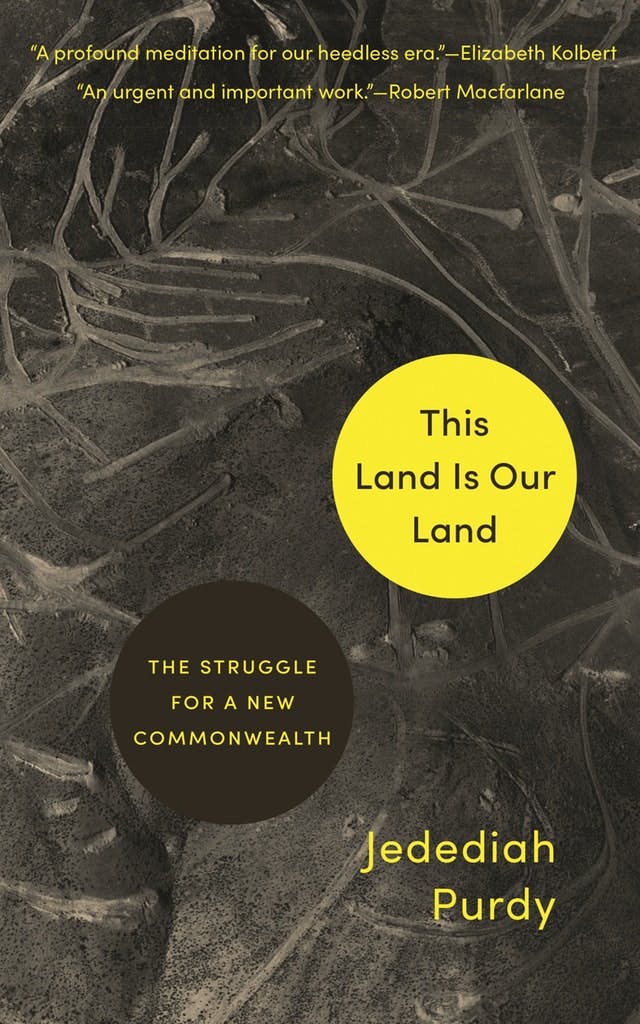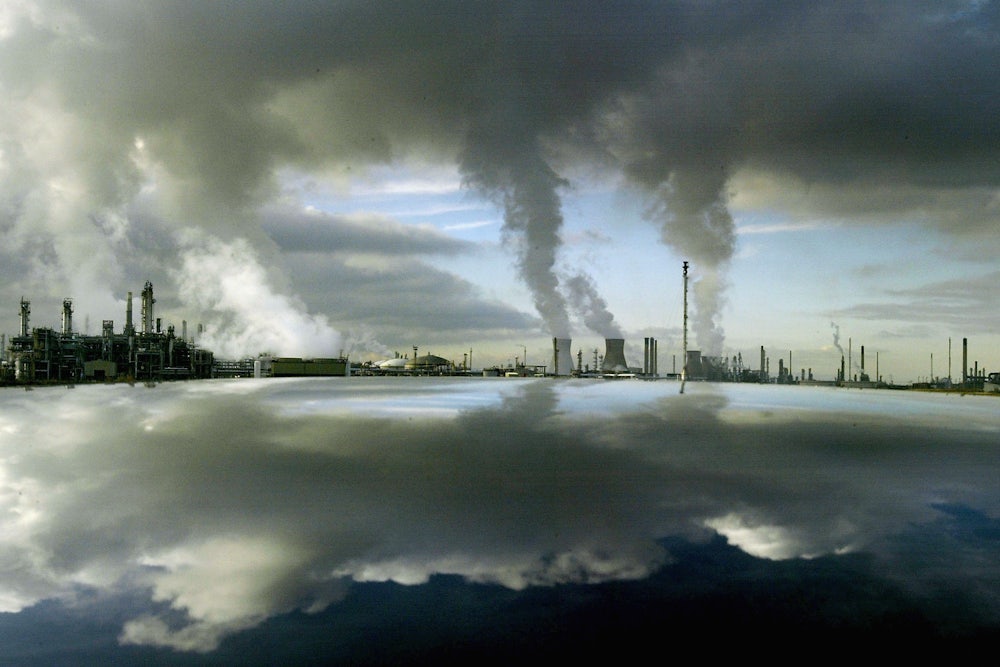Climate denialism is back. For decades, denialists rejected truths about the environment: the link between carbon emissions and global warming, the human role in rising emissions, and the adequacy of climate modeling. That old form of denialism is buckling under the weight of the growing number of disasters clearly generated by our changing climate. In this era of climate crises, denialism often takes a new guise: The facts denied now concern human nature, rather than that of the world around us.
The loudest proselytizer of this “neo-denialism” is Jonathan Franzen. In a controversial New Yorker essay, Franzen scorns the “unrealistic hope” of preventing climate apocalypse. Rebuffing the denialism of the past, Franzen is certain that the horrors of climate change are real. But he is equally certain that there is little we can do to prevent those horrors from becoming reality. His argument against hope begins with the idea that the “point of no return” for climate catastrophe is a two-degree Celsius rise in global average temperature. Once such warming occurs, the world will spin out of our control in a series of cascading environmental transformations that will doom much of humanity. To prevent this death spiral, every country must “institute draconian conservation measures” and “completely retool its economy.” However, our “psychology” of complacency and myopic self-interest fuels a “political reality” of government inaction, making the necessary restructuring impossible.
“Call me a pessimist,” Franzen writes, “but I don’t see human nature fundamentally changing anytime soon.” Attempts to halt a snowballing crisis are therefore both hopeless and “actively harmful,” as they divert our efforts away from “smaller, more local battles that you have some realistic hope of winning.” In fighting such battles—like Franzen’s pet project, saving endangered bird populations—we can embrace “hope for today,” rather than hope for a “future … undoubtedly worse than the present.”
Franzen’s piece has been widely ridiculed as the misguided musings of an ill-informed novelist. Its characterization of a two-degree temperature shift as a “point of no return” misinterprets climate science. Its argument that addressing environmental problems is a zero-sum game, rather than a fight of overlapping battles with synergistic solutions, is wrong. And its author, who once blew a $78,000 inheritance on a self-described “seeing it before it melts” cruise to Antarctica, has a perspective woefully distorted by privilege; indeed, as a wealthy white man, he is among those least likely to bear the burdens of climate disaster.
These points all ring true. Yet many of Franzen’s critics seem to agree with his diagnosis, that our defective human nature undermines effective climate action. As one critic admits, our tendency toward “complacency and procrastination” makes Franzen’s pessimism “justified.” Similar beliefs can be found across the climate discourse. We Are the Weather: Saving the Planet Begins at Breakfast, Jonathan Safran Foer’s argument for diet-based climate revolution, roots the dearth of collective climate action in “emotional limits” that prevent us from caring about massive problems. Likewise, David Wallace-Wells, author of The Uninhabitable Earth: Life After Warming, believes our capacity for “psychic compartmentalization and denial” will likely drive inadequate climate policy well into the future.
The trouble with accepting Franzen’s diagnosis is
that it requires accepting his prognosis. For him, it doesn’t matter whether
humanity’s wipe-out point lies at two degrees Celsius or four; so long as
indifference toward the future and one another is permanently written into our
nature, the restructuring necessary to halt climate change lies beyond our
reach. Foer may think that “individual decisions” to give up meat will bring a
“wave” of similar climate-saving actions. Wallace-Wells can hope that the
“climate alarmism” of the few will spur and grow popular movements for change.
But in embracing the immutability of human nature, both authors follow Franzen
in denying the possibility of organizing these small-scale changes into mass
movements. Whatever optimism they have is hollow, rejecting the form of neo-denialism
while embracing its function.
This “season of denialism” is the subject of Jedediah Purdy’s new collection of essays, This Land is Our Land: The Struggle for a New Commonwealth. Purdy, a law professor at Columbia who specializes in environmental politics, describes this new denialism as stemming from “a lack of faith” in humanity, rather than “ignorance” of environmental truths. This Land is a search for the foundations of this faithlessness, conducted through a series of clear-eyed explorations of polluted American landscapes. In bayous flooded by petrochemicals in Louisiana, farms despoiled by fracking in Pennsylvania, and rivers smothered by mountaintop removal in his native West Virginia, Purdy hits on the same problem that Franzen does: a “fractured” politics that makes collective will “hard to muster.” Purdy, too, believes that the climate crisis “will grow,” causing increasingly disastrous storms, droughts, migrations, and wars; he “can hardly fault anyone” for pessimism about environmental salvation “when the evidence for despair is so weighty and clear.”

But while Franzen assumes he has come up against unalterable human shortcomings, Purdy looks further, at the environment that shapes attitudes and political will. Gauging our odds of survival requires looking into the soil below; just as climate catastrophes are “human creations,” so too are humans an outgrowth of the land beneath them. The “division and exploitation” that have largely prevented collective action on climate change, Purdy argues, “is also written on the land.” The Federal Housing Administration no longer advocates redlining, yet segregated neighborhoods continue to reflect its effects, sapping black wealth. Homesteading, which carved up native property for settler profit generations ago, undergirds present-day assaults on public lands by white militias. The breaking of labor unions in the late twentieth century is responsible, as much as any methane leak, for lethal explosions in twenty-first century Appalachian coal mines.
The sources of our world-despoiling power are the “terms of land making that made American wealth so unequal.” We are “creatures of our built environment, an infrastructure species.” A “collective technological exoskeleton, circulatory system, and network of nerves form the conditions of our existence.” This infrastructure consists not only of 30 trillion tons of roads, cities, housing, and cropland, but also the “immaterial systems that connect people,” such as money and the law. It is a network of power, resources, and rules that requires every individual to act through it, deforming “our power really to choose the terms of our relations to one another and to the nonhuman world.” Think about choosing to eat less meat, which Foer says is “probably the most important action an individual can take to reverse global warming.” That choice is constrained by advertising and regulations that shape our preferences toward eating meat, along with billions in subsidies that make those preferences cheap and easy to satisfy. It is not our nature but our economy—the “way we organize our world”—that is “driving our slow but accelerating disaster for both human and nonhuman life.”
It is not novel to say the economy is the cause of environmental evils. But Purdy pairs this claim with an argument that economies “do not arise naturally, whether from the self-interest of ‘rational man’ or from the disruptive imagination of entrepreneurs.” Patterns of consumption and distribution, he reminds us, do not reflect our innate biases, failures and preferences; markets, prices, and profit-seeking are no more natural than race, class, or any other social construct. Moreover, these creations are fundamentally interlinked; markets sustain unequal distributions, prices reflect past prejudices, and power defines our preferences. In its totality, this “political economy” pushes upon us an “extractive, inequality-producing logic of commodification,” so that, whatever choices we make, “we are locked into making ourselves instruments of one another’s profits.”
Purdy believes the vehicle for change is This Land’s titular “commonwealth,” a “stronger program of common care, one that can overcome all forms of denialism” by tying land, people, and their jointly-made fruits together to share the wealth of the earth equally. Key to its achievement is an understanding that “the American commonwealth has been blocked again and again by division and exploitation—by racism, misshapen ideas of manhood and of women, and the subtle and outright violence of owners and bosses, usually all interwoven.” Thus, any successful project to end climate change through commonwealth politics must first “radicalize environmentalism” by recognizing that “economic power, racial inequality, and the struggles of indigenous peoples are not optional or supplemental. They are the heart of the work. They always have been.”
Despite the scale of this task, Purdy has faith that we can accomplish it. “If the problem is the world we have built, then it is in our power to build another.” Grounding this faith is “history,” which Purdy says reveals that “a commonwealth is not a gauzy utopian ideal: It is radical and practical.” A piece of this history comes in This Land’s best chapter, which details the “long” environmental justice movement. Born in the 1980s, that movement criticizes mainstream environmentalism for being too white, overly elite, and ignorant of how environmental harms disproportionately hurt the poor and people of color. Purdy traces the problems back to pioneers like John Muir, whose conservation ethic was inextricable from colonialism and white supremacy: Muir derided the laziness of “Sambos” and the “dirty and irregular life” of indigenous people living near Yosemite, while promising park tourists that “as to Indians, most of them are dead or civilized into useless innocence.” The federal government made good on this promise in creating many National Parks, driving native people from their homes to foster a pristine wilderness for middle-class whites.
Purdy also finds many strains of environmentalism that incorporated environmental justice principles long before they were written down. He mentions for instance the Wilderness Society head Robert Marshall, who was integral in reforms that pushed the federal government toward both conservationism and supporting the sovereignty of Native American nations. Yet when the modern environmental movement arose in the 1970s, its leaders inadvertently imbued their creation with Muir’s vision rather than Marshall’s; by not attending directly to matters of power, race, and class, the laws and organizations they created flowed with, rather than fought, the unequal currents of the broader political economy. If we can learn from their failures, Purdy declares, “we do not need to be trapped by our history of self-division.”
Purdy spends little time describing specific methods for building a commonwealth, beyond a few pages on efforts like the Green New Deal. A chapter that described concrete proposals to make Purdy’s optimism real, or provided additional histories to justify that optimism, might have been of more practical use than the chapter on Purdy’s metaphysical struggles with the 2016 election. But at under 200 pages, This Land’s omissions are likely intentional. The book is best seen in the context of the budding law and political economy movement, an attempt to bring concepts of democracy and power to the forefront of legal scholarship, teaching, and practice. This Land might be that movement’s environmental creed—a necessary thing in the fight to fix our planet, given that, as Purdy says, “no material change in power will go forward without ideas and images that give it shape and a horizon to aim for.”
Purdy, who is co-director of the Law & Political Economy Project, knows that his book is a first draft, with details to be filled in, tenets revised, and action items drafted by activists, students, scholars, and practitioners. In this way, This Land reaffirms its most basic assertion of faith: that we can change our world because it is “deeply plural at every scale and … we are in it together.” Acting on that faith requires us to move beyond Franzen’s defeatism, to recant the belief that human nature is as fixed as it is flawed. If we realize that humans are creatures of context—defined by an economy that we can redefine—we will discover not only that the road to climate salvation is real, but also that we cannot walk it alone.
